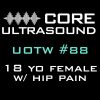A 29 y/o male progressive shortness of breath over the last 2-3 weeks. He states that he went to another emergency department 2 days prior where a chest X-ray was performed that was read as negative for acute process, and this morning he received the news that his COVID test came back negative. On review of systems, the patient reports generalized fatigue and nausea, without vomiting. When asked about IV drug use, the patient reports he occasionally does IV heroin, but denies use over the past 2-3 weeks due to his current physical ailments. The patient also reports that he smokes approximately one pack of cigarettes a day
On exam, his vital signs are as follows: HR 102, RR 22, T 37.2ºC, BP 112/69, SpO2 96% R/A. Auscultation reveals minimal wheezing in bilateral bases. Skin exam demonstrates track marks over bilateral forearms.
Portable, bedside ultrasound is performed and reveals the following image:
What do the clips show? What is the diagnosis? (Click the button for the answer!)

Tricuspid Valve Endocarditis Using the RV Inflow View
Beside ultrasound demonstrates a vegetation on the tricuspid valve, consistent with infectious endocarditis (IE). The patient was admitted for IV antibiotics and drug rehabilitation. Subsequent blood cultures grew out S. Aureus, which is the most common cause of tricuspid valve endocarditis.1
- Staphylococcus species are currently the most common cause of IE.2 Although often seen in patients with a history of intravenous drug use, the most common age of disease is >70 years old.2
- Diagnosis should be made based on integration of the history, physical exam, microbiological analysis and imaging results, including echocardiography.2
- Right sided endocarditis, as in our case, is seen in 5-10% of cases of IE.2
- When evaluating a patient with suspicion of endocarditis, specific views highlighting the valves are often used. For tricuspid valve endocarditis, the subxiphoid and apical 4 chamber views typically offer good views of the tricuspid valve. However, in some patients, the subxiphoid and apical 4 chamber views may be difficult to perform.
- The parasternal RV inflow view can be used by tilting the transducer beam slightly more anteriorly after obtaining a traditional parasternal long axis view (see figure below for a tutorial)
- In a systematic review and meta-analysis that included 11 studies of patients with suspected native valve endocarditis evaluated with transesophageal echocardiography as the gold standard, transthoracic echocardiography was found to have a sensitivity of 71%, specificity of 80%, positive likelihood ratio of 3.56 and a negative likelihood ratio of 0.37.2
Authors: Jacob Avila, MD
Peer Reviewer: Terren Trott, MD
References
- Hussain ST, Witten J, Shrestha NK, Blackstone EH, Pettersson GB. Tricuspid valve endocarditis. Ann Cardiothorac Surg. 2017 May;6(3):255-261. doi: 10.21037/acs.2017.03.09. PMID: 28706868; PMCID: PMC5494428.
- Cahill TJ, Prendergast BD. Infective endocarditis. Lancet. 2016 Feb 27;387(10021):882-93. doi: 10.1016/S0140-6736(15)00067-7. Epub 2015 Sep 1. PMID: 26341945.
- Bonzi M, Cernuschi G, Solbiati M, Giusti G, Montano N, Ceriani E. Diagnostic accuracy of transthoracic echocardiography to identify native valve infective endocarditis: a systematic review and meta-analysis. Intern Emerg Med. 2018 Sep;13(6):937-946. doi: 10.1007/s11739-018-1831-0. Epub 2018 Mar 15. PMID: 29546685.




